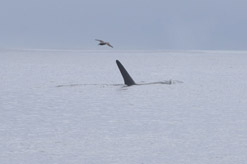|
On October 31, our captain John Mayer spotted some killer whales just
beyond the canyon edge, 8 miles northwest of Pt. Pinos. After watching
the whales for a short time, he suspected that they were the offshore
type. There are three types of killer whales found in the North Pacific,
"transients" or mammal hunters (seen most often in Monterey), "residents"
(fish hunters, which often travel through Monterey in winter, and are
most often off Washington state), and the "offshores", a type which is
least known with a few observations of them feeding on sharks and fish.
Males of this type have a more rounded and narrow fin than transients
and females, also with a rounded fin. They tend to have many notches and
scratches in their dorsal fin, possibly from catching sharks. On a whale
watch trip many years ago, we (Nancy Black and Richard Ternullo) observed
them catch a blue shark. However, there are very few observations of the
food types for offshores. The offshores are one population, in that all
the whales (around 350-500 in population) range from Southern California
to the Bering Sea. The groups typically range in size from 10 to over
100, with most sightings numbering 20-100 whales. Unlike the transients
and residents which exist in distinct groups (such as southern residents,
northern residents, Alaskan residents) that range over part of their entire
population range, the offshores consist of one population.
On this day, there were around 25 whales, as offshores are often found
in large scattered groups. Just after they arrived, Captain John and naturalist
Shawn Swing on our whale watch trip observed part of the group catch and
feed on an Opah, an unusual fish usually found in warmer waters. Isiah
Foulks, our deckhand, was quick enough to photograph the Opah with the
whales. The fish was about 4' long and weighed about 100 lbs. Opahs are
a laterally flattened, silver fish, with gray spots and crimson (bright
orange) fins, a very beautiful fish known to be occasionally caught by
fishermen in offshore waters of Monterey with albacore. John first observed
a group of about six whales bringing the Opah to the surface, including
some bubble bursts by the whales to likely confuse the fish. John saw
that one female type whale brought the fish up in its mouth and let it
go as 3-4 whales tightly surrounded it on the surface, preventing the
fish from escaping. The fish was definitely in the mouth of the whale
and looked injured. After a short time, another whale grabbed the fish
and pulled it under. Within a few minutes, the whales tore up the fish
as several gulls and a few albatross were seen picking pieces and small
gut parts out of the water. It looked similar to the way transients feed
on their mammal prey, such as harbor seals, which they quickly consume.
This is the first time that we know of offshore killer whales feeding
on Opah, a very important observation adding to our knowledge of this
type of whale.
Alisa Schulman-Janiger and I (Nancy Black) dashed out after the whale
watch returned and were able to locate the whales again with the help
of boater Eric Mailander. We both had been working on our update to our
previously published killer whale identification catalog, and Alisa has
been up here for several weeks from Los Angeles. We followed the whales
for just over four hours until dark as they slowly traveled south, and
we left them a few miles off of Pt. Lobos. They remained in subgroups
of 2-5 whales spread just under a mile. Some were curious about the boat
and passed us closely, with a few tail slaps and syphops. They were mostly
in the travel mode and not obviously feeding. There were about five albatross'
following the whales, as these seabirds often seem to follow killer whales
in hopes of picking up leftover pieces if they disperse their prey near
the surface. We were able to photograph the group and recognized many
whales from previous sightings. We are analyzing the photos from this
sighting to determine matches to other areas, as we have previously documented
matches from Southern California, Monterey and as far as the Bering Sea.
Everyone was very excited about the event, with some passengers amazed
at how many killer whales were present and also appreciated seeing them
in the wild. We will continue to look for this group again, or possibly
more groups could pass through, as many offshores are seen on the outer
coast of the Queen Charlotte Islands/Alaska during the summer (also some
throughout the year) and are seen off California primarily during late
fall to early spring (more in winter). Our last Monterey offshore sighting
was March 2011 and the last California sighting was January 2012 off Southern
California.
LINKS:
More on the offshore killer whale ecotype:
Eastern
temperate North Pacific offshore killer whales (Orcinus orca):
Occurrence, movements, and insights into feeding ecology
Paper by Marilyn Dahlheim, Alisa Schulman-Janiger, Nancy Black, Richard
Ternullo, Dave Ellifrit, and Kenneth C. Balcomb III, published in Marine
Mammal Science in July 2008:
More about Opah:
Opah
Images
Opah
seen more often off Southern California - San Diego researchers join effort
to better understand the species
NOAA
FishWatch - Opah
Hawaii
Seafood - Moonfish (Opah)

Offshore Killer Whales and Opah
|
 |

Offshore Killer Whales and Opah
|
 |

Offshore Killer Whales
|

Albatross and Killer Whale
|
 |

Bull Offshore Killer Whale
|
 |

Killer Whale Spyhopping
|
|
![]()
![]()
